Want to see an updated, corrected, and generally better version of this article? Check it out at its new home on Suburban Pagans.
The lines between good and evil in Bollywood movies tend to be pretty broadly drawn, but never so broadly, it seems, as when the great Amrish Puri was cast as the villain. Deep of the voice, wild of the eye, and massive of the brow, Puri, though a versatile actor who played many diverse roles in his four decade career, truly made his mark with his portrayals of over-the-top bad guys in countless Bollywood action and masala movies (And yes, yes, I know…as Mola Ram in that Indiana Jones movie. Give it a rest, for chrissakes!). Many of these portrayals were iconic, but, while Puri would star in nearly four hundred films by the time of his death in 2005, there is one film for which he is remembered most of all.
Tahalka, however, is not that film. In fact, judging by the paucity of information I encountered when trying to glean such simple facts about the film as the year in which it was made, I get the impression that nobody much remembers Tahalka at all. About an equal number of sites list its release date as either 1982 or 1992, and also spell it’s name variably as “Tahalka” or “Tehelka”. A couple of filmographies for Puri actually list both a “Tahalka” for 1982 and a “Tehelka” for 1992, though I’m pretty sure that those are both references to the same film. Given this, I think it’s safe to say that Tahalka–or whatever it’s called–is not held in the same fond regard as certain other of its stars’ cinematic vessels.
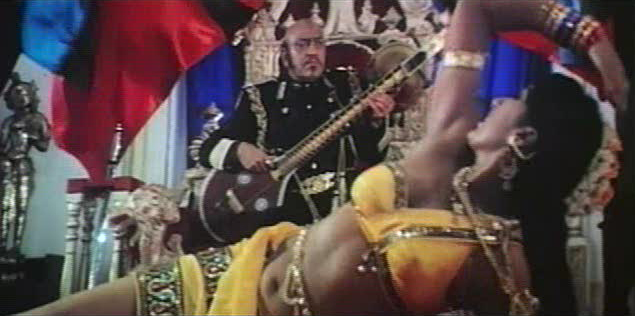

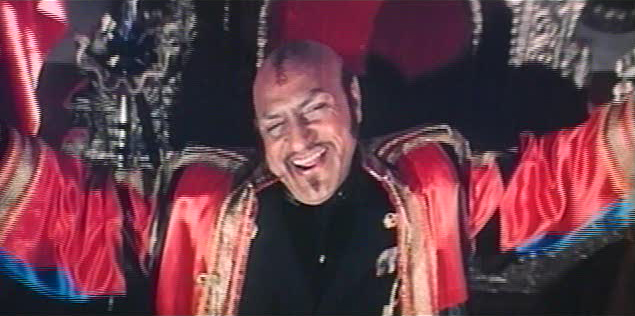
As for when Tahalka was made, I think it’s pretty safe to go with 1992. For one thing, Dharmendra looks really old in this movie. Furthermore, the film’s songs–written by Anu Malik–are terrible in that distinctly early 90s Bollywood way, filled with clunky dance rhythms and people shouting out random English phrases like they were Japanese magazine covers with Tourette’s Syndrome. (I’m talking Karisma Kapoor terrible, people.) But what nails down Tahalka‘s vintage most of all is how it so clearly post-dates the 1987 film Mr. India, a fact evidenced by how obviously the filmmakers intended for Puri’s character, General Dong, to echo his iconic portrayal of the super villain Mogambo in that earlier film, right down to the endlessly repeated catchphrase.
But, this issue aside, what is it about Tahalka that has relegated it to such forgotten status? What could be so wrong with a film–one of a not all that distant vintage and featuring fairly bankable stars–that the record of it could become so murky in the scant intervening years? Perhaps to find out, what we need to do is listen to Tahalka, and by that means let the film itself tell us exactly where the problem lies.
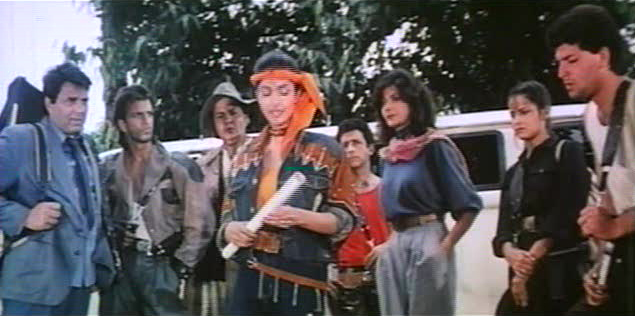
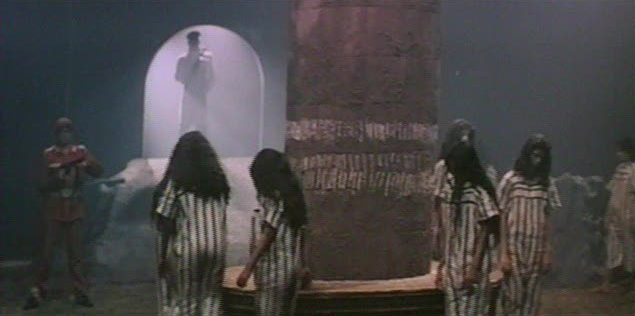
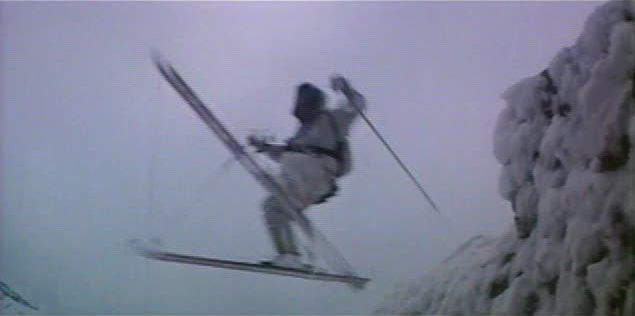
The disclaimers at the beginning of Bollywood movies, which are often in English, are things of beauty in themselves, and they’re something that I’ve only recently learned to pay attention to. Rather than being generic boilerplate drawn up by a team of faceless lawyers, they tend to be a kind of freeform verse that gives us a fascinating window into the psyche of the filmmakers. One of my favorites is the one that precedes Papi Gudia, the 1996 remake of the Hollywood film Child’s Play, which states that the movie’s intention is to warn children “against blind faith or surrender to alien things be it a doll or computer toys, robots, etc.” In the case of Tahalka, the pre-credits disclaimer reads:
“The Story of this feature film ‘Tahalka’ is imaginary and unfolds in the imaginary environment of imaginary countries. It has nothing to do with India or any other country or their inhabitants, governments, defense forces, or their existing facts and realities.”
Now, that all seems pretty comprehensive, but apparently out of a feeling that not quite a fine enough point has been put on things, the disclaimer continues:
“It is reiterated that all the characters, incidents, places and environments are fictitious and have no relationship what so ever with any person living or dead. If any resemblance to any character or incident appears at any stage, it is just a coincidence.”
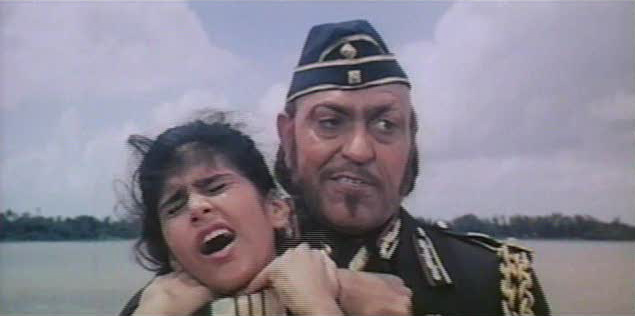


This conspicuous abundance of caution might alert the canny reader to the possibility that Tahalka‘s chatty disclaimer might not be entirely on the level. I mean, to paraphrase Shakespeare, could Tahalka hath possibly protested any more? And are we seriously meant to accept that what is depicted in a film made in India by, presumably, inhabitants of India, only bears a resemblance to India and its inhabitants as the result of coincidence, if at all? One gets the sense that Tahalka has something to hide, and perhaps we might get a clue as to what that something might be once the movie proper has started.
Tahalka proper starts with a panoramic view of the Himalayas, over which a narrator intones that these are the borders of “the nation that the world calls India”. After this a map appears on the screen depicting India, Pakistan and China, with each country clearly labeled, over which the narrator states that beyond these borders lie those countries “whose greed penetrates into ours and crosses its limits”, whose inhabitants “wish to color the ground of India red with the blood of Indians themselves and shatter India into a million pieces”.
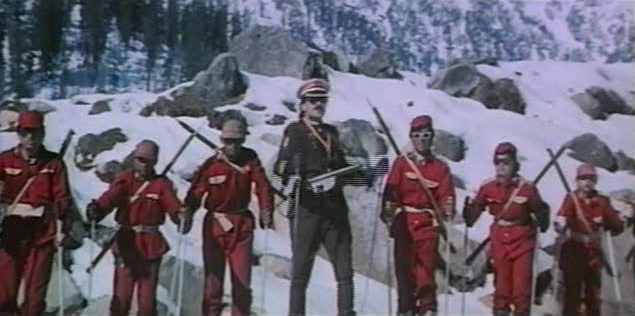


Incendiary talk, for sure. But don’t get the wrong idea, because–even though it isn’t shown on the map that’s being displayed on screen–the country that the narrator is talking about isn’t China or Pakistan, but rather the completely made up country of Dongrila. And as we are shown the sights of Dongrila–consisting mostly of crude models of vaguely orientalist structures situated on snowy model train-set peaks, interspersed with footage of a Buddhist monk strolling down a village street–the narrator tells us that Dongrila was once “made prosperous by India itself, nurtured and nourished”. Now, however, this remote mountain paradise has fallen into the hands of a brutal dictator, the man known as General Dong.
Now, it’s not difficult to figure out where all of this is coming from. After all, the late eighties and early nineties were another period during which tensions between China and India were at close to a full boil–fueled in part by the Chinese government’s perception of India as interfering in their affairs in Tibet–and the looming potential for renewed clashes along the countries’ disputed border region, such as had been seen as recently as 1986, was a daily reality. However, that this is so obviously the scab that Tahalka is trying to pick–and with such rhetorical ferocity, to boot–makes it a little harder to understand the eleventh hour backpedalling that the opening disclaimer seems to be evidence of.
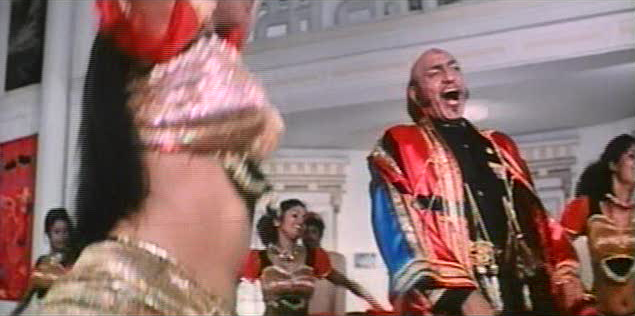

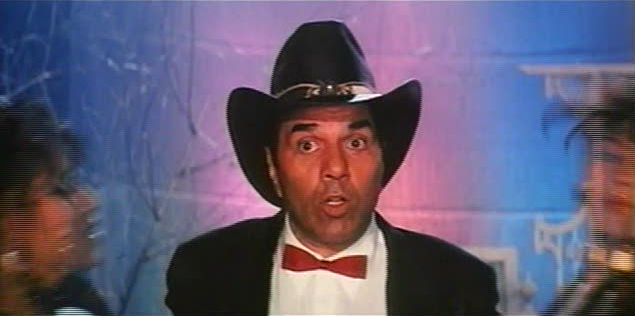
If it was, in fact, the film’s director, Anil Sharma, who was reticent about casting stones at China directly, he’d gotten over such circumspection by the time of finally having his first box office success with 2001’s Gadar: Ek Prem Katha. That film caused considerable public outcry with its perceived anti-Muslim and anti-Pakistani sentiments–sentiments that were delivered without resort to fanciful pseudonyms or references to imaginary lands. Whatever the case, though, if the makers of Tahalka were trying to exploit what they saw as some deep sense of national injury on the part of their potential audience, they failed miserably, because the inhabitants of India apparently stayed away from the film in droves.
Anyway, once Tahalka has established itself as being annoyingly passive-aggressive, it proceeds with an opening sequence that is very similar to Mr. India‘s, featuring an anxious minion of General Dong’s rushing to have an audience with the fearsome general himself. After that minion, Major D’Costa (Sunil Dhawan), is hurried–amid much Hitler saluting and shouting of “Long live Dong!”–through various checkpoints, and down a number of long, heavily guarded corridors, he is finally ushered into Dong’s palatial inner sanctum, where. with the portentous striking of a gong, we finally get a look at our already much ballyhooed villain.



And what a villain is our General Dong. Establishing the Mogambo connection right off the bat, Puri is both bethroned and bedecked in a fanciful military uniform, and also comes with a numbingly repeated catchphrase: “Dong is never wrong”. But in a departure from his obvious model, Dong also boasts a look in which no signifier of orientalist treachery is spared: the puttied eyelids, the Fu Manchu ‘stache and goatee, the long braid, and, just in case you didn’t get it, stretching across his bald pate, a tattoo of a Chinese dragon. Though Puri’s booming basso profundo was one of his trademarks, when we finally hear him speak as Dong, he does so with a squeaky “ah so” Chinaman voice, peppering his utterances with fits of high pitched giggling. That is, except for those random scenes in which Puri just talks in the deep, threatening tones of Mogambo–indicating that, at some point during filming, a switch was decided upon. Oh, you sloppy, sloppy Tahalka!
But we don’t actually get to hear Dong speak at first, for it is at this point that the moment which makes Tahalka worth its price of admission occurs. Rather than greeting us, as he normally would, with a richly intoned declaration of villainous intent, Amrish Puri stands… and begins to sing. (And check the playback singers credits; that really is him singing.) And then he dances–not just a half-hearted little jig or two-step, mind you, but honest to God, hip-thrusting, fist-pumping getting down, with an array of swirling, scantily clad back-up dancers to goad him on. To top it all off, Amrish grabs a sitar mid-number and rocks it like Eddie Van Halen.
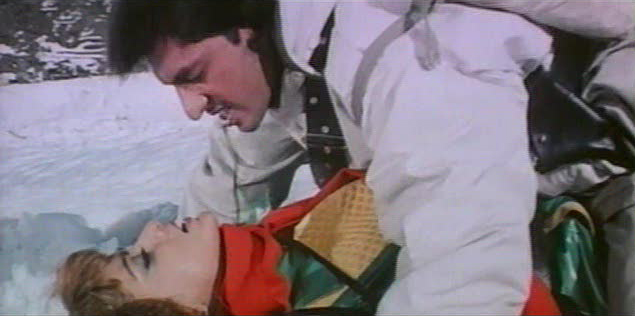
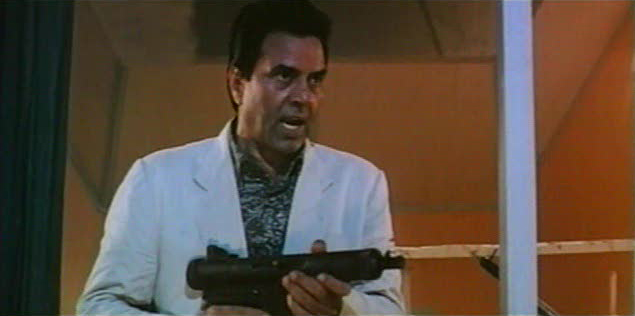
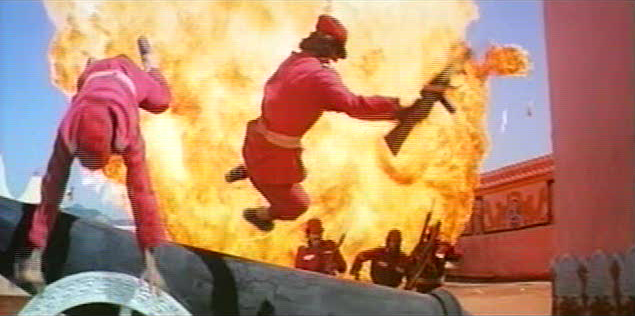
Of course, the “song” that Dong/Amrish sings can only be called such by the loosest standards, because the lyrics consist only of the word “shom” repeated over and over again. This, completing the odiousness of the portrait that’s being painted, is apparently meant as a mockery of the Buddhist chant “om”–assuring us once and for all that Tahalka‘s makers will stop at nothing, and in turn causing us to anticipate with resignation the moment when Dong will pee in someone’s Coke.
With the “Shom Shom” song out of the way, Dong gets down to villainy. The unfortunate General D’Costa, we learn, has just returned from leading a failed incursion which resulted in two thousand of Dong’s troops dying at the hands of India’s defense forces. As punishment, Dong orders D’Costa to perform ritual suicide in the city square in front of all of Dongrila’s citizens. But first we get a tour of Dong’s suicide bomber farm; this consists of a dank dungeon in which captive young girls, hypnotized into submission by Dong, spend their waking hours walking in dazed circles while chained to a big rock, waiting for the day when they will be called upon to don a bomb belt and die for the greater glory of Dong. Then, with D’Costa dispatched, Dong sets about planning his revenge against India. Not one to delegate a matter of such importance, Dong accomplishes this task personally with the aid of several “duplicate Dongs”, who distract security while the real Dong hijacks a tank at an Indian military parade and blows up the general responsible for the Indian counter-attack.
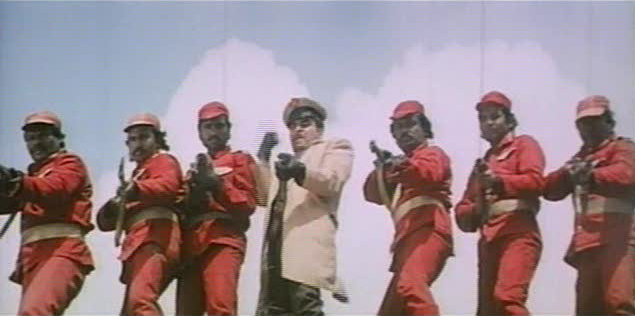
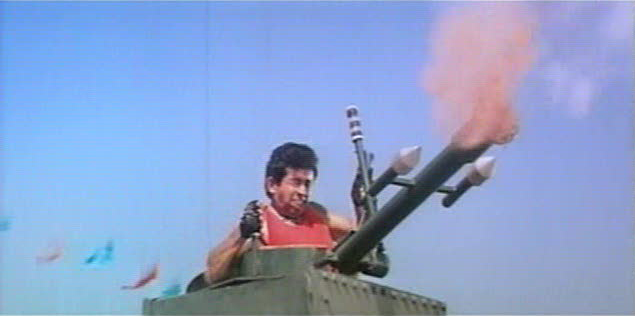
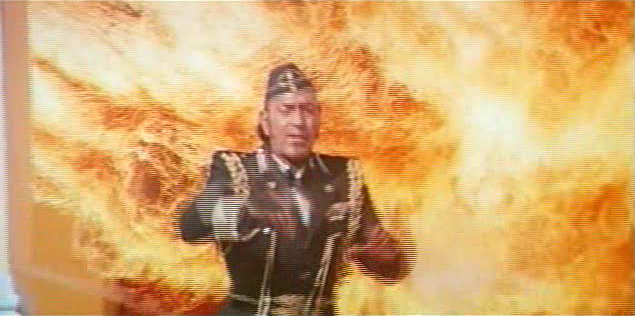
With this, India’s defense forces decide that they have had it up to here with General Dong, and it is decided that a commando unit will be sent into Dongrila to eliminate him in a top secret, surgical strike. The bearded and intense Major Rao (Mukesh Khanna) is eager to lead this operation, because he has a quite understandable beef with Dong. A year earlier, while on a fishing trip with his young daughter, he stumbled upon an island that Dong operated as a sort of processing center for the kidnapped Indian schoolgirls destined to become his suicide bombers and sex slaves. Rao managed to aid some of those girls in escaping, but in the process Dong took his daughter captive. To taunt Rao, Dong gave him a year to come back for his daughter, after which he would, um, turn her out–then cut off Rao’s leg with a sword and cast him off to sea. Rao is now so eager to go after Dong that he already has a whole plan drawn up, and a hand-picked crew of elite commandos to go with him.
But forget elite, what we want to know about those commandos is: are they wacky? And the answer, sickeningly, is yes, with a capital wack. At this point we are introduced to Rao’s three male commandos (Aditya Pancholi, Naseeruddin Shah, and Javed Jaffrey) in a series of scenes in which they try to hit on girls by indulging in some of the most spine-chilling instances of male cross-dressing ever committed to film, and then by pretending to be blind. Their dickishness firmly established, we follow the gang as they are introduced to the team’s fifth member, Capt. Anju Sinha (Ekta Kapoor). And she’s a guh.. a guh.. a girl! Still, the team is not yet complete, for a sixth is needed, despite the fact that everyone keeps referring to the group as “Force Five” (not to be confused with the Americanized Go Nagai cartoon series of the same name–which doesn’t really need to be pointed out except to underscore what a complete nerd I am).
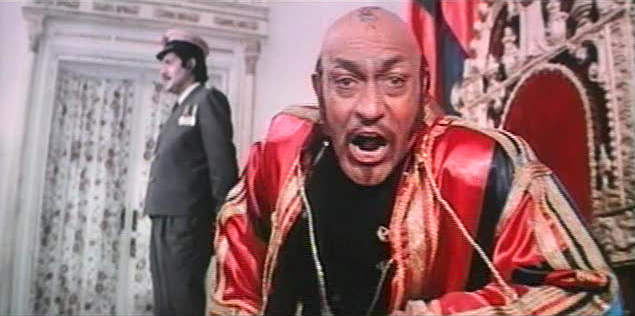


Because the territory surrounding Dongrila is dangerous and valley-ridden–and in fact includes a region called “Danger Valley” (which I’m pretty sure is made up)–a veteran with combat experience in the region is needed. Such a man is disgraced former army Major Dharam Singh, who is played by, as I alluded to earlier, a very old and tired-looking Dharmendra. Of course, Dharam Singh was only court marshaled because he was a patriotic super soldier who disobeyed orders in order to save thousands of Indian lives, and he’s understandably bitter about it. Getting him to sign on for this mission will take much convincing and passionate appeals to his patriotism, and so the team heads off to Bangkok, where Dharam Singh is living easy–though not so easy that he can’t take part in an elaborate night club number where he sings about “Rocking Around the Clock” while shimmying laboriously with a bunch of Thai chorus girls.
I won’t tell you what happens next, because I don’t want to spoil it, but suffice it to say that Dharam Singh eventually agrees to join the mission… Oh, there, I just spoiled it. Anyway, soon the team of six are trekking out across the icy, mountainous landscape, encountering many dangers along the way, including an underground cavern filled with crabs and snakes. (There’s a lot that I don’t know about zoology, and I’ll have to add the Himalayan Cave-Dwelling Snow Crab to that list.) Finally they manage to cross into Dongrila, though not without having to survive many skirmishes with Dong’s forces (which include Bob Christo! Yay!). After defending themselves by throwing wasp’s nests at the enemy and tricking them into drinking their piss, Force Five finally makes it’s way to a safe house operated by a small band of resistance fighters lead by Prince Kao (Prem Chopra, wearing a hat that has little corks dangling from its brim).
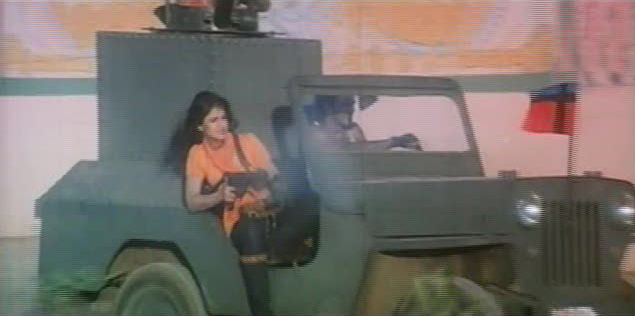

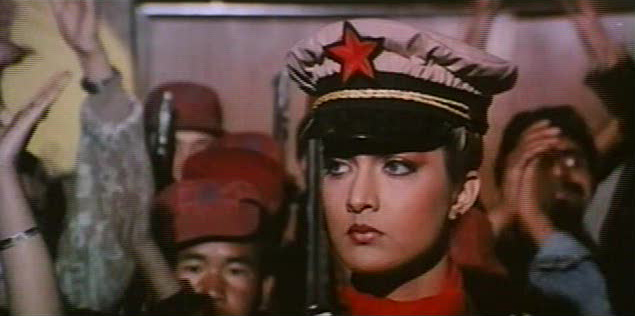
Though Major Rau is the leader of the commandos, he also proves to be their greatest liability, thanks to the fact that his prosthetic leg just doesn’t want to stay attached to his body. This leads to a scene in which Rau must flee from General Dong’s advancing ski troops by skiing on one leg, using his pole with one hand and carrying his prosthetic leg–with the ski still attached to it–in the other. Eventually Rau’s stump becomes gangrenous, which means that Force Five must sneak their way into Dongrila’s only hospital, located deep within the heavily guarded central city. This may represent the only instance in the history of Bollywood that such an incursion is not accomplished by means of the commandos disguising themselves as a dance troupe. Rather, the soldiers commandeer a truck and costumes belonging to a troupe of Laurel & Hardy impersonators. Now, I have not seen Where Eagles Dare, but I realize that it is a film to which Tahalka owes a considerable debt. Still I’m guessing that there isn’t a scene in Where Eagle’s Dare in which Richard Burton and Clint Eastwood dress up like Laurel & Hardy and sing a song based on “Old MacDonald”. I’m just guessing, of course.
Many of Tahalka‘s exteriors and larger scale action sequences are accomplished by means of some particularly dodgy model work, which means that portions of Tahalka look like an especially half-assed episode of Thunderbirds. In fact, there is a model of a cable car line spanning a mountainous valley that looks suspiciously like the one used in Commando; so if you’ve seen Commando, you know what I’m talking about. Unfortunately, Tahalka misses the opportunity to have someone have a fight with Amrish Puri while dangling from that cable car, which means that Tahalka loses out to Commando on the awesomeness scale by a wide mark.



One convention of 1980s Hollywood action movies that Bollywood embraced wholeheartedly–and it’s one that I think is as much inherited from slasher movies as it is an aspect of action movies’ function as an exorcist of national demons–is the idea that vengeance cannot be achieved unless we see the villain completely physically obliterated. It’s never enough just to shoot the guy; we also have to see him fall off the top of a skyscraper on fire with a hand grenade in his mouth before we can truly feel that justice has been served. Following this tradition, once our heroes have caught up with Dong, Tahalka serves up a long climactic scene in which all of the remaining cast members take turns kicking him repeatedly in the chest–to the accompaniment of that car door slamming noise that always accompanies people kicking somebody in the chest in Bollywood movies–before Dharmendra lifts Dong’s broken body above his head and hurls it into a raging fire.
These scenes of brutality in Bollywood movies of this vintage always get to me for some reason–partially because they stand out so much from the affable frivolity of much of what surrounds them, but also because, for all their righteous patriotic rage, they present an image of an India that has a gigantic chip on it’s shoulder. I have to believe that this is an inaccurate representation, because, otherwise, everyone in the country would be too busy shouting defiant proclamations and firing rocket launchers across their borders for that whole economic miracle thing to have happened in the first place. In the case of Tahalka, what also strikes me is that–just as with the very similar climax of Mr. India–the somewhat elderly Amrish Puri doesn’t seem to be using a stunt double while most of this kicking, beating and tossing is taking place. The man is a consummate professional.

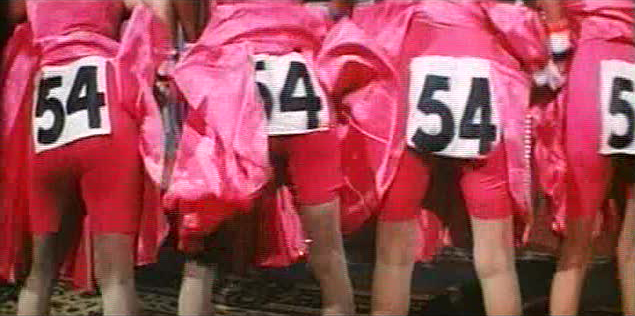

And given that he is such a professional, I can’t help being a little miffed on Puri’s behalf at Tahalka‘s makers. It’s much like the feeling I get watching Lee Van Cleef in the awful Captain Apache; The filmmakers in that case knew that they were working with an actor who would, out of a disciplined professional ethic, do whatever was asked of him, even if that involved croaking out an awful, psychedelic-tinged theme tune and letting people call him “red ass” all the time. That those filmmakers then went ahead and asked Van Cleef to do just that seems like something on the level of abuse, and the same goes for Anil Sharma and company in Puri’s case. Puri once said that the reason he didn’t pursue further roles in Hollywood films after his turn as Mola Ram was that he didn’t like the way that Indians were portrayed in those films. Given that–in addition to reports that Puri, despite his screen persona, was a kindly and gentle man–I’d like to believe that the portrayal of General Dong was not something that he could entirely get behind, and that he undertook it only out of a humble dedication to the practice of his chosen craft.
So, in the final tally, singing and dancing Amrish or no, it’s difficult to get past the fact that Tahalka is a furiously awful film. Of course, that’s mitigated somewhat by all the hate-mongering– Oh, wait, that doesn’t really mitigate things at all, does it? Nope. Tahalka just sucks from top to bottom. Still, it’s nice how a derivative film can make you appreciate anew that from which it steals, and Tahalka definitely spurred me to new levels of admiration for the sure-handed direction and comparably high production values of Mr. India, even though Mr. India is one of the goofiest, cheesiest things I’ve ever seen.
This is not to say that I don’t recommend Tahalka, of course. It certainly contains enough retarded insanity and cheapjack spectacle to keep you moderately engaged for the majority of its three hours, even if it does leave you feeling a little soiled. For that reason I’d suggest that, if you do decide to invest your time in it, you do so as a tribute to the late, great Mr. Puri, because that’s an act which would almost make Tahalka seem worthwhile.
